Ambrosia beetles are beetles of the weevil subfamilies Scolytinae and Platypodinae, which live in nutritional symbiosis with ambrosia fungi. The beetles excavate tunnels in dead or stressed trees into which they introduce fungal gardens, their sole source of nutrition. After landing on a suitable tree, an ambrosia beetle excavates a tunnel in which it releases its fungal symbiont. The fungus penetrates the plant's xylem tissue, extracts nutrients from it, and concentrates the nutrients on and near the surface of the beetle gallery. Ambrosia fungi are typically poor wood degraders, and instead utilize less demanding nutrients. Symbiotic fungi produce and detoxify ethanol, which is an attractant for ambrosia beetles and likely prevents growth of antagonistic pathogens and selects for other beneficial symbionts. The majority of ambrosia beetles colonize xylem of recently dead trees, but some colonize stressed trees that are still alive, and a few species attack healthy trees. Species differ in their preference for different parts of trees, different stages of deterioration, and in the shape of their tunnels ("galleries"). However, the majority of ambrosia beetles are not specialized to any taxonomic group of hosts, unlike most phytophagous organisms including the closely related bark beetles. One species of ambrosia beetle, Austroplatypus incompertus exhibits eusociality, one of the few organisms outside of Hymenoptera and Isoptera to do so.

Buchnera aphidicola, a member of the Pseudomonadota and the only species in the genus Buchnera, is the primary endosymbiont of aphids, and has been studied in the pea aphid, Acyrthosiphon pisum. Buchnera is believed to have had a free-living, Gram-negative ancestor similar to a modern Enterobacterales, such as Escherichia coli. Buchnera is 3 μm in diameter and has some of the key characteristics of its Enterobacterales relatives, such as a Gram-negative cell wall. However, unlike most other Gram-negative bacteria, Buchnera lacks the genes to produce lipopolysaccharides for its outer membrane. The long association with aphids and the limitation of crossover events due to strictly vertical transmission has seen the deletion of genes required for anaerobic respiration, the synthesis of amino sugars, fatty acids, phospholipids, and complex carbohydrates. This has resulted not only in one of the smallest known genomes of any living organism, but also one of the most genetically stable.
Adenotrophic viviparity means "gland fed, live birth". This is the reproductive mode of insects such as tsetse flies (Glossinidae), keds (Hippoboscidae) and bat flies, as adenotrophic viviparity is a characteristic feature of the superfamily Hippoboscoidea. It has also been observed in members of the subfamily Mesembrinellinae.
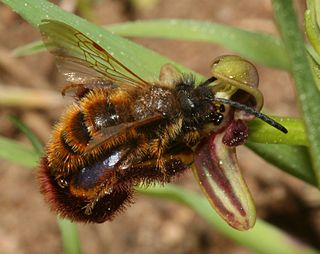
An allomone is a type of semiochemical produced and released by an individual of one species that affects the behaviour of a member of another species to the benefit of the originator but not the receiver. Production of allomones is a common form of defense against predators, particularly by plant species against insect herbivores. In addition to defense, allomones are also used by organisms to obtain their prey or to hinder any surrounding competitors.
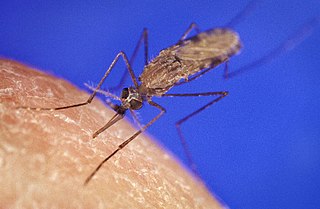
The Anopheles gambiae complex consists of at least seven morphologically indistinguishable species of mosquitoes in the genus Anopheles. The complex was recognised in the 1960s and includes the most important vectors of malaria in sub-Saharan Africa, particularly of the most dangerous malaria parasite, Plasmodium falciparum. It is one of the most efficient malaria vectors known. The An. gambiae mosquito additionally transmits Wuchereria bancrofti which causes lymphatic filariasis, a symptom of which is elephantiasis.

The term mycangium is used in biology for special structures on the body of an animal that are adapted for the transport of symbiotic fungi. This is seen in many xylophagous insects, which apparently derive much of their nutrition from the digestion of various fungi that are growing amidst the wood fibers. In some cases, as in ambrosia beetles, the fungi are the sole food, and the excavations in the wood are simply to make a suitable microenvironment for the fungus to grow. In other cases, wood tissue is the main food, and fungi weaken the defense response from the host plant.

Fenoxycarb is a carbamate insect growth regulator. It has a low toxicity for bees, birds, and humans, but is toxic to fish. The oral LD50 for rats is greater than 16,800 milligrams per kilogram (0.269 oz/lb).

The Laboulbeniales is an order of fungi within the class Laboulbeniomycetes. They are also known by the colloquial name beetle hangers or labouls. The order includes around 2,325 species of obligate insect ectoparasites that produce cellular thalli from two-celled ascospores. Of the described Laboulbeniales, Weir and Hammond 1997 find 80% to be from Coleoptera and the next largest group to be the 10% from Diptera. Recently, the genus Herpomyces, traditionally considered a basal member of Laboulbeniales, was transferred to the order Herpomycetales based on molecular phylogenetic data. Laboulbeniales typically do not kill their hosts, although they may impair host fitness if the parasite density is high.

May Roberta Berenbaum is an American entomologist whose research focuses on the chemical interactions between herbivorous insects and their host plants, and the implications of these interactions on the organization of natural communities and the evolution of species. She is particularly interested in nectar, plant phytochemicals, honey and bees, and her research has important implications for beekeeping.
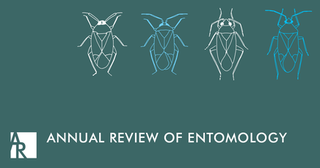
The Annual Review of Entomology is a peer-reviewed academic journal that publishes review articles about entomology, the study of insects. First published in 1956 from a collaboration between the Entomological Society of America and Annual Reviews, its longest-serving editors are Thomas E. Mittler (1967–1997) and May Berenbaum (1998–2018). As of 2023, Annual Review of Entomology is being published as open access, under the Subscribe to Open model. Also as of 2023, Journal Citation Reports gives the journal a 2022 impact factor of 23.8, ranking it first of 100 journals in the category "Entomology".
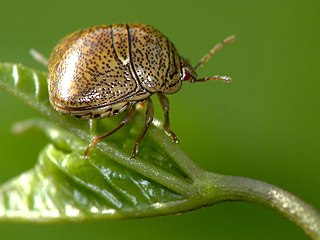
Megacopta cribraria, also called the bean plataspid, kudzu bug, globular stink bug and lablab bug, is a shield bug native to India and China, where it is an agricultural pest of lablab beans and other legumes. The bug, while harmless to houseplants and people, often enters houses. It is attracted to white surfaces such as the walls of houses or white vehicles, because of the high reflectance of the white surfaces as it relates to the bugs' simple eyes. As a defense mechanism, they emit a foul-smelling pheromone that also acts as a congregation pheromone. Aside from smelling foul, the liquid also creates a burning sensation and sometimes leaves a red welt on bare skin. It is similar to other Plataspidae in having a somewhat unusual symbiotic relationship with its gut bacteria. Before laying eggs, females deposit particles containing the symbiont, which are then eaten by newly hatched nymphs under natural conditions. Nymphs experimentally deprived of access to the symbiont exhibited slower growth, smaller body sizes and higher mortality.

Fat body is a highly dynamic insect tissue composed primarily of storage cells. It is distributed throughout the insect's internal body cavity, in close proximity to the hemolymph as well as organs such as the epidermis, digestive organs and ovaries. Its main functions are nutrient storage and metabolism, for which it is commonly compared to a combination of adipose tissue and liver in mammals. However, it may also serve a variety of other roles, such as: endocrine regulation, systemic immunity, vitellogenesis, and main site of production of antimicrobial molecules called antimicrobial peptides.
Diana L. Six is a forest entomologist and professor at the University of Montana. Her research focuses primarily on bark beetle ecology and forest adaptation to climate change. Six is the recipient of the 2018 Edward O. Wilson Biodiversity Technology Pioneer Award, has presented at TEDx, and has been featured in National Geographic among other nationally recognized media.

Glossina morsitans is a species of tsetse fly in the genus Glossina. It is one of the major vectors of Trypanosoma brucei rhodesiense in African savannas.
Orseolia oryzivora, also called the African rice gall midge, is a species of small fly in the family Cecidomyiidae. It is a major insect pest of rice crops in Africa.
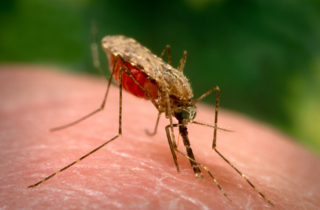
Anopheles arabiensis is a zoophilic species of mosquito and a vector of disease endemic to Africa.
Anopheles sundaicus is a zoophilic mosquito of southeast Asia.
Various tetradecadienyl acetate compounds serve as insect mating pheromones especially among the Pyralidae. These include:
Polyethism is the term used for functional specialization of non-reproductive individuals in a colony of social organisms, particularly insects. Division of labour is considered a key aspect of eusociality and can be seen in a variety of forms. In some insects, there are distinct morphological differences among the individuals that decide their function in the colony, and this is termed as caste or morphological polyethism and is associated with polymorphism. Functions of individuals within the colony that are identical in morphology may however vary in the tasks taken up with the age of the individuals. In some species riskier activities are taken up by older individuals. This is termed as age polyethism. Time- and season-related specialization may also be termed more generically as temporal polyethism. The mechanisms involved in the control of polyethism has been an area of intense research in the field of sociobiology.
Ambrosiella roeperi is the fungal symbiont of the granulate ambrosia beetle, Xylosandrus crassiusculus, facilitating this insect’s capacity to accumulate on and damage a diverse array of woody plants from around the world. It is one of several important nutritional partners derived from order Microascales that sustain and are transported by xylomycetophagous scolytine beetles.











